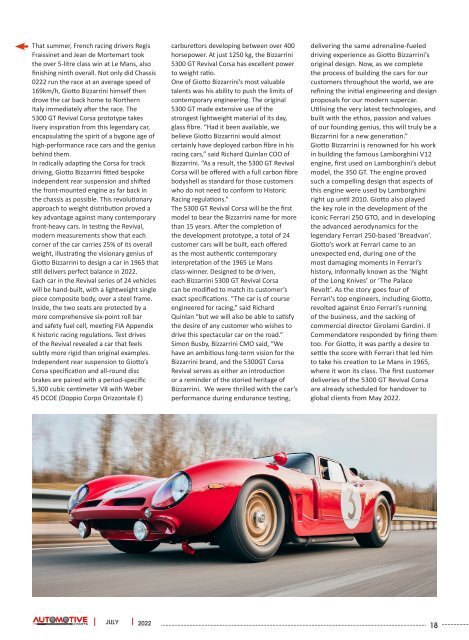Create successful ePaper yourself
Turn your PDF publications into a flip-book with our unique Google optimized e-Paper software.
That summer, French racing drivers Regis<br />
Fraissinet and Jean de Mortemart took<br />
the over 5-litre class win at Le Mans, also<br />
finishing ninth overall. Not only did Chassis<br />
0222 run the race at an average speed of<br />
169km/h, Giotto Bizzarrini himself then<br />
drove the car back home to Northern<br />
Italy immediately after the race. The<br />
5300 GT Revival Corsa prototype takes<br />
livery inspiration from this legendary car,<br />
encapsulating the spirit of a bygone age of<br />
high-performance race cars and the genius<br />
behind them.<br />
In radically adapting the Corsa for track<br />
driving, Giotto Bizzarrini fitted bespoke<br />
independent rear suspension and shifted<br />
the front-mounted engine as far back in<br />
the chassis as possible. This revolutionary<br />
approach to weight distribution proved a<br />
key advantage against many contemporary<br />
front-heavy cars. In testing the Revival,<br />
modern measurements show that each<br />
corner of the car carries 25% of its overall<br />
weight, illustrating the visionary genius of<br />
Giotto Bizzarrini to design a car in 1965 that<br />
still delivers perfect balance in <strong>2022</strong>.<br />
Each car in the Revival series of 24 vehicles<br />
will be hand-built, with a lightweight single<br />
piece composite body, over a steel frame.<br />
Inside, the two seats are protected by a<br />
more comprehensive six-point roll bar<br />
and safety fuel cell, meeting FIA Appendix<br />
K historic racing regulations. Test drives<br />
of the Revival revealed a car that feels<br />
subtly more rigid than original examples.<br />
Independent rear suspension to Giotto’s<br />
Corsa specification and all-round disc<br />
brakes are paired with a period-specific<br />
5,300 cubic centimeter V8 with Weber<br />
45 DCOE (Doppio Corpo Orizzontale E)<br />
carburettors developing between over 400<br />
horsepower. At just 1250 kg, the Bizzarrini<br />
5300 GT Revival Corsa has excellent power<br />
to weight ratio.<br />
One of Giotto Bizzarrini’s most valuable<br />
talents was his ability to push the limits of<br />
contemporary engineering. The original<br />
5300 GT made extensive use of the<br />
strongest lightweight material of its day,<br />
glass fibre. “Had it been available, we<br />
believe Giotto Bizzarrini would almost<br />
certainly have deployed carbon fibre in his<br />
racing cars,” said Richard Quinlan COO of<br />
Bizzarrini. “As a result, the 5300 GT Revival<br />
Corsa will be offered with a full carbon fibre<br />
bodyshell as standard for those customers<br />
who do not need to conform to Historic<br />
Racing regulations.”<br />
The 5300 GT Revival Corsa will be the first<br />
model to bear the Bizzarrini name for more<br />
than 15 years. After the completion of<br />
the development prototype, a total of 24<br />
customer cars will be built, each offered<br />
as the most authentic contemporary<br />
interpretation of the 1965 Le Mans<br />
class-winner. Designed to be driven,<br />
each Bizzarrini 5300 GT Revival Corsa<br />
can be modified to match its customer’s<br />
exact specifications. “The car is of course<br />
engineered for racing,” said Richard<br />
Quinlan “but we will also be able to satisfy<br />
the desire of any customer who wishes to<br />
drive this spectacular car on the road.”<br />
Simon Busby, Bizzarrini CMO said, “We<br />
have an ambitious long-term vision for the<br />
Bizzarrini brand, and the 5300GT Corsa<br />
Revival serves as either an introduction<br />
or a reminder of the storied heritage of<br />
Bizzarrini. We were thrilled with the car’s<br />
performance during endurance testing,<br />
delivering the same adrenaline-fueled<br />
driving experience as Giotto Bizzarrini’s<br />
original design. Now, as we complete<br />
the process of building the cars for our<br />
customers throughout the world, we are<br />
refining the initial engineering and design<br />
proposals for our modern supercar.<br />
Utilising the very latest technologies, and<br />
built with the ethos, passion and values<br />
of our founding genius, this will truly be a<br />
Bizzarrini for a new generation.”<br />
Giotto Bizzarrini is renowned for his work<br />
in building the famous Lamborghini V12<br />
engine, first used on Lamborghini’s debut<br />
model, the 350 GT. The engine proved<br />
such a compelling design that aspects of<br />
this engine were used by Lamborghini<br />
right up until 2010. Giotto also played<br />
the key role in the development of the<br />
iconic Ferrari 250 GTO, and in developing<br />
the advanced aerodynamics for the<br />
legendary Ferrari 250-based ‘Breadvan’.<br />
Giotto’s work at Ferrari came to an<br />
unexpected end, during one of the<br />
most damaging moments in Ferrari’s<br />
history, informally known as the ‘Night<br />
of the Long Knives’ or ‘The Palace<br />
Revolt’. As the story goes four of<br />
Ferrari’s top engineers, including Giotto,<br />
revolted against Enzo Ferrari’s running<br />
of the business, and the sacking of<br />
commercial director Girolami Gardini. Il<br />
Commendatore responded by firing them<br />
too. For Giotto, it was partly a desire to<br />
settle the score with Ferrari that led him<br />
to take his creation to Le Mans in 1965,<br />
where it won its class. The first customer<br />
deliveries of the 5300 GT Revival Corsa<br />
are already scheduled for handover to<br />
global clients from May <strong>2022</strong>.<br />
JULY<br />
<strong>2022</strong><br />
18

















